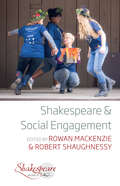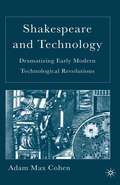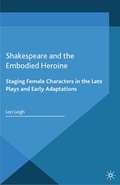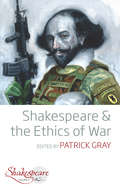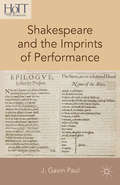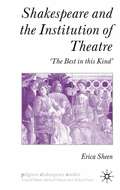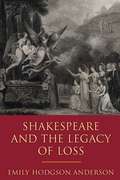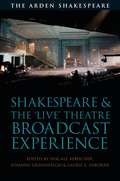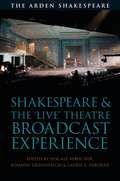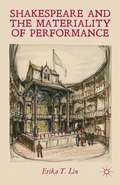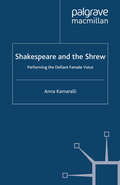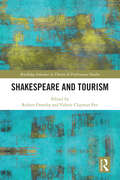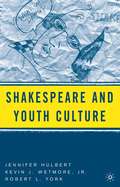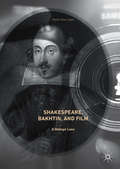- Table View
- List View
Shakespeare and Social Engagement (Shakespeare & #10)
by Rowan Mackenzie and Robert ShaughnessyShakespeare’s roots in applied and participatory performance practices have been recently explored within a wide variety of educational, theatrical and community settings. Shakespeare and Social Engagement explores these settings, as well as audiences who have largely been excluded from existing accounts of Shakespeare’s performance history. The contributions in this collected volume explore the complicated and vibrant encounters between a canonical cultural force and work that frequently characterizes itself as inclusive and egalitarian.
Shakespeare and Social Engagement (Shakespeare & #10)
by Robert Shaughnessy Rowan MackenzieShakespeare’s roots in applied and participatory performance practices have been recently explored within a wide variety of educational, theatrical and community settings. Shakespeare and Social Engagement explores these settings, as well as audiences who have largely been excluded from existing accounts of Shakespeare’s performance history. The contributions in this collected volume explore the complicated and vibrant encounters between a canonical cultural force and work that frequently characterizes itself as inclusive and egalitarian.
Shakespeare and Social Engagement (Shakespeare & #10)
Shakespeare’s roots in applied and participatory performance practices have been recently explored within a wide variety of educational, theatrical and community settings. Shakespeare and Social Engagement explores these settings, as well as audiences who have largely been excluded from existing accounts of Shakespeare’s performance history. The contributions in this collected volume explore the complicated and vibrant encounters between a canonical cultural force and work that frequently characterizes itself as inclusive and egalitarian.
Shakespeare and Technology: Dramatizing Early Modern Technological Revolutions
by A. CohenBy reading the plays in technological contexts, Cohen offers new insights into some of Shakespeare's key metaphors, his methods of character development and plot development, his ideas about genre, his concept of theatrical space, and his views on the theatre's role in society.
Shakespeare and the denial of territory: Banishment, abuse of power and strategies of resistance
by Pascale DrouetThis book analyses three Shakespearean plays that particularly deal with abusive forms of banishment: King Richard II, Coriolanus, and King Lear. In these plays, the abuses of power are triggered by fearless speeches that question the legitimacy of power and are misinterpreted as breaches of allegiance; in these plays, both the bold speech of the fearless speaker and the performative sentence of the banisher trigger the relentless dynamics of what Deleuze and Guattari termed ‘deterritorialisation’. This book approaches the central question of the abusive denial of territory from various angles: linguistic, legal and ethical, physical and psychological. Various strategies of resistance are explored: illegal return, which takes the form of a frontal counterattack employing a ‘war machine’; ruse and the experience of internal(ised) exile; and mental escape, which nonetheless may lead to madness, exhaustion or heartbreak.
Shakespeare and the denial of territory: Banishment, abuse of power and strategies of resistance
by Pascale DrouetThis book analyses three Shakespearean plays that particularly deal with abusive forms of banishment: King Richard II, Coriolanus, and King Lear. In these plays, the abuses of power are triggered by fearless speeches that question the legitimacy of power and are misinterpreted as breaches of allegiance; in these plays, both the bold speech of the fearless speaker and the performative sentence of the banisher trigger the relentless dynamics of what Deleuze and Guattari termed ‘deterritorialisation’. This book approaches the central question of the abusive denial of territory from various angles: linguistic, legal and ethical, physical and psychological. Various strategies of resistance are explored: illegal return, which takes the form of a frontal counterattack employing a ‘war machine’; ruse and the experience of internal(ised) exile; and mental escape, which nonetheless may lead to madness, exhaustion or heartbreak.
Shakespeare and the Embodied Heroine: Staging Female Characters in the Late Plays and Early Adaptations (Palgrave Shakespeare Studies)
by L. LeighShakespeare and the Embodied Heroine is a bold new investigation of Shakespeare's female characters using the late plays and the early adaptations written and staged during the seventeenth and eighteenth century.
Shakespeare and the Ethics of War (Shakespeare & #5)
by Patrick GrayHow does Shakespeare represent war? This volume reviews scholarship to date on the question and introduces new perspectives, looking at contemporary conflict through the lens of the past. Through his haunting depiction of historical bloodshed, including the Trojan War, the fall of the Roman Republic, and the Wars of the Roses, Shakespeare illuminates more recent political violence, ranging from the British occupation of Ireland to the Spanish Civil War, the Balkans War, and the past several decades of U. S. military engagement in Iraq and Afghanistan. Can a war be just? What is the relation between the ruler and the ruled? What motivates ethnic violence? Shakespeare’s plays serve as the frame for careful explorations of perennial problems of human co-existence: the politics of honor, the ethics of diplomacy, the responsibility of non-combatants, and the tension between idealism and Realpolitik.
Shakespeare and the Imprints of Performance (History of Text Technologies)
by J. Gavin PaulWithin the study of drama, the question of how to relate text and performance—and what interpretive tools are best suited to analyzing them—is a longstanding and contentious one. Most scholars agree that reading a printed play is a means of dramatic realization absolutely unlike live performance, but everything else beyond this premise is contestable: how much authority to assign to playwrights, the extent to which texts and readings determine performance, and the capability of printed plays to communicate the possibilities of performance. Without denying that printed plays distort and fragment performance practice, this book negotiates an intractable debate by shifting attention to the ways in which these inevitable distortions can nevertheless enrich a reader's awareness of a play's performance potentialities. As author J. Gavin Paul demonstrates, printed plays can be more meaningfully engaged with actual performance than is typically assumed, via specific editorial principles and strategies. Focusing on the long history of Shakespearean editing, he develops the concept of the performancescape: a textual representation of performance potential that gives relative shape and stability to what is dynamic and multifarious.
Shakespeare and the Institution of Theatre: ‘The Best in this Kind’ (Palgrave Shakespeare Studies)
by E. SheenThis innovative book offers an interdisciplinary analysis of Shakespearean theatre, presented in a series of imaginative readings of plays from every period of the playwright's career, from Two Gentlemen of Verona and The Taming of the Shrew to King Lear and The Tempest , mapping a new approach to ideas of the theatre as an institution.
Shakespeare and the Legacy of Loss
by Emily Hodgson AndersonHow do we recapture, or hold on to, the live performances we most love, and the talented artists and performers we most revere? Shakespeare and the Legacy of Loss tells the story of how 18th-century actors, novelists, and artists, key among them David Garrick, struggled with these questions through their reenactments of Shakespearean plays. For these artists, the resurgence of Shakespeare, a playwright whose works just decades earlier had nearly been erased, represented their own chance for eternal life. Despite the ephemeral nature of performance, Garrick and company would find a way to make Shakespeare, and through him the actor, rise again. In chapters featuring Othello, Richard III, Hamlet, The Winter’s Tale, and The Merchant of Venice, Emily Hodgson Anderson illuminates how Garrick’s performances of Shakespeare came to offer his contemporaries an alternative and even an antidote to the commemoration associated with the monument, the portrait, and the printed text. The first account to read 18th-century visual and textual references to Shakespeare alongside the performance history of his plays, this innovative study sheds new light on how we experience performance, and why we gravitate toward an art, and artists, we know will disappear.
Shakespeare and the 'Live' Theatre Broadcast Experience
by Pascale Aebischer Susanne Greenhalgh Laurie OsborneThis ground breaking collection of essays is the first to examine the phenomenon of how, in the twenty-first century, Shakespeare has been experienced as a 'live' or 'as-live' theatre broadcast by audiences around the world. Shakespeare and the 'Live' Theatre Broadcast Experience explores the precursors of this phenomenon and its role in Shakespeare's continuing globalization. It considers some of the most important companies that have produced such broadcasts since 2009, including NT Live, Globe on Screen, RSC Live from Stratford-upon-Avon, Stratford Festival HD, Kenneth Branagh Theatre Company Live, and Cheek by Jowl, and examines the impact these broadcasts have had on branding, ideology, style and access to Shakespeare for international audiences. Contributors from around the world reflect on how broadcasts impact on actors' performances, changing viewing practices, local and international Shakespearean fan cultures and the use of social media by audience members for whom “liveness” is increasingly tied up in the experience economy. The book tackles vexing questions regarding the 'presentness' and 'liveness' of performance in the 21st century, the reception of Shakespeare in a globally-connected environment, the challenges of sustaining an audience for stage Shakespeare, and the ideological implications of consuming theatre on screen. It will be crucial reading for scholars of the 'live' theatre broadcast, and enormously helpful for scholars of Shakespeare on screen and in performance more broadly.
Shakespeare and the 'Live' Theatre Broadcast Experience
by Pascale Aebischer Susanne Greenhalgh Laurie OsborneThis ground breaking collection of essays is the first to examine the phenomenon of how, in the twenty-first century, Shakespeare has been experienced as a 'live' or 'as-live' theatre broadcast by audiences around the world. Shakespeare and the 'Live' Theatre Broadcast Experience explores the precursors of this phenomenon and its role in Shakespeare's continuing globalization. It considers some of the most important companies that have produced such broadcasts since 2009, including NT Live, Globe on Screen, RSC Live from Stratford-upon-Avon, Stratford Festival HD, Kenneth Branagh Theatre Company Live, and Cheek by Jowl, and examines the impact these broadcasts have had on branding, ideology, style and access to Shakespeare for international audiences. Contributors from around the world reflect on how broadcasts impact on actors' performances, changing viewing practices, local and international Shakespearean fan cultures and the use of social media by audience members for whom “liveness” is increasingly tied up in the experience economy. The book tackles vexing questions regarding the 'presentness' and 'liveness' of performance in the 21st century, the reception of Shakespeare in a globally-connected environment, the challenges of sustaining an audience for stage Shakespeare, and the ideological implications of consuming theatre on screen. It will be crucial reading for scholars of the 'live' theatre broadcast, and enormously helpful for scholars of Shakespeare on screen and in performance more broadly.
Shakespeare and the Materiality of Performance
by E. LinWinner of the MRDS 2013 David Bevington Award for Best New Book in Early Drama Studies! Drawing on a wide variety of primary sources, Lin reconstructs playgoers' typical ways of thinking and feeling and demonstrates how these culturally-trained habits of mind shaped dramatic narratives and the presentational dynamics of onstage action.
Shakespeare and the Power of the Face
by James A. KnappThroughout his plays, Shakespeare placed an extraordinary emphasis on the power of the face to reveal or conceal moral character and emotion, repeatedly inviting the audience to attend carefully to facial features and expressions. The essays collected here disclose that an attention to the power of the face in Shakespeare’s England helps explain moments when Shakespeare’s language of the self becomes intertwined with his language of the face. As the range of these essays demonstrates, an attention to Shakespeare’s treatment of faces has implications for our understanding of the historical and cultural context in which he wrote, as well as the significance of the face for the ongoing interpretation and production of the plays. Engaging with a variety of critical strands that have emerged from the so-called turn to the body, the contributors to this volume argue that Shakespeare’s invitation to look to the face for clues to inner character is not an invitation to seek a static text beneath an external image, but rather to experience the power of the face to initiate reflection, judgment, and action. The evidence of the plays suggests that Shakespeare understood that this experience was extremely complex and mysterious. By turning attention to the face, the collection offers important new analyses of a key feature of Shakespeare’s dramatic attention to the part of the body that garnered the most commentary in early modern England. By bringing together critics interested in material culture studies with those focused on philosophies of self and other and historians and theorists of performance, Shakespeare and the Power of the Face constitutes a significant contribution to our growing understanding of attitudes towards embodiment in Shakespeare’s England.
Shakespeare and the Power of the Face
by James A. KnappThroughout his plays, Shakespeare placed an extraordinary emphasis on the power of the face to reveal or conceal moral character and emotion, repeatedly inviting the audience to attend carefully to facial features and expressions. The essays collected here disclose that an attention to the power of the face in Shakespeare’s England helps explain moments when Shakespeare’s language of the self becomes intertwined with his language of the face. As the range of these essays demonstrates, an attention to Shakespeare’s treatment of faces has implications for our understanding of the historical and cultural context in which he wrote, as well as the significance of the face for the ongoing interpretation and production of the plays. Engaging with a variety of critical strands that have emerged from the so-called turn to the body, the contributors to this volume argue that Shakespeare’s invitation to look to the face for clues to inner character is not an invitation to seek a static text beneath an external image, but rather to experience the power of the face to initiate reflection, judgment, and action. The evidence of the plays suggests that Shakespeare understood that this experience was extremely complex and mysterious. By turning attention to the face, the collection offers important new analyses of a key feature of Shakespeare’s dramatic attention to the part of the body that garnered the most commentary in early modern England. By bringing together critics interested in material culture studies with those focused on philosophies of self and other and historians and theorists of performance, Shakespeare and the Power of the Face constitutes a significant contribution to our growing understanding of attitudes towards embodiment in Shakespeare’s England.
Shakespeare and the Shrew: Performing the Defiant Female Voice (Palgrave Shakespeare Studies)
by A. KamaralliAn investigation of the many ways that Shakespeare uses the defiant voice of the shrew. Kamaralli explores how modern performance practice negotiates the possibilities for staging these characters who refuse to conform to standards of acceptable behaviour for women, but are among Shakespeare's bravest, wisest and most vivid creations.
Shakespeare and the Theater of Religious Conviction in Early Modern England
by Walter S LimThis book analyzes Shakespeare’s use of biblical allusions and evocation of doctrinal topics in Hamlet, Measure for Measure, The Winter’s Tale, Richard II, and The Merchant of Venice. It identifies references to theological and doctrinal commonplaces such as sin, grace, confession, damnation, and the Fall in these plays, affirming that Shakespeare’s literary imagination is very much influenced by his familiarity with the Bible and also with matters of church doctrine. This theological and doctrinal subject matter also derives its significance from genres as diverse as travel narratives, sermons, political treatises, and royal proclamations. This study looks at how Shakespeare’s deployment of religious topics interacts with ideas circulating via other cultural texts and genres in society. It also analyzes how religion enables Shakespeare’s engagement with cultural debates and political developments in England: absolutism and law; radical political theory; morality and law; and conceptions of nationhood.
Shakespeare and the Visual Arts: The Italian Influence (Anglo-Italian Renaissance Studies)
by Michele MarrapodiCritical investigation into the rubric of 'Shakespeare and the visual arts' has generally focused on the influence exerted by the works of Shakespeare on a number of artists, painters, and sculptors in the course of the centuries. Drawing on the poetics of intertextuality and profiting from the more recent concepts of cultural mobility and permeability between cultures in the early modern period, this volume’s tripartite structure considers instead the relationship between Renaissance material arts, theatre, and emblems as an integrated and intermedial genre, explores the use and function of Italian visual culture in Shakespeare’s oeuvre, and questions the appropriation of the arts in the production of the drama of Shakespeare and his contemporaries. By studying the intermediality between theatre and the visual arts, the volume extols drama as a hybrid genre, combining the figurative power of imagery with the plasticity of the acting process, and explains the tri-dimensional quality of the dramatic discourse in the verbal-visual interaction, the stagecraft of the performance, and the natural legacy of the iconographical topoi of painting’s cognitive structures. This methodolical approach opens up a new perspective in the intermedial construction of Shakespearean and early modern drama, extending the concept of theatrical intertextuality to the field of pictorial arts and their social-cultural resonance. An afterword written by an expert in the field, a rich bibliography of primary and secondary literature, and a detailed Index round off the volume.
Shakespeare and the Visual Arts: The Italian Influence (Anglo-Italian Renaissance Studies)
by Michele MarrapodiCritical investigation into the rubric of 'Shakespeare and the visual arts' has generally focused on the influence exerted by the works of Shakespeare on a number of artists, painters, and sculptors in the course of the centuries. Drawing on the poetics of intertextuality and profiting from the more recent concepts of cultural mobility and permeability between cultures in the early modern period, this volume’s tripartite structure considers instead the relationship between Renaissance material arts, theatre, and emblems as an integrated and intermedial genre, explores the use and function of Italian visual culture in Shakespeare’s oeuvre, and questions the appropriation of the arts in the production of the drama of Shakespeare and his contemporaries. By studying the intermediality between theatre and the visual arts, the volume extols drama as a hybrid genre, combining the figurative power of imagery with the plasticity of the acting process, and explains the tri-dimensional quality of the dramatic discourse in the verbal-visual interaction, the stagecraft of the performance, and the natural legacy of the iconographical topoi of painting’s cognitive structures. This methodolical approach opens up a new perspective in the intermedial construction of Shakespearean and early modern drama, extending the concept of theatrical intertextuality to the field of pictorial arts and their social-cultural resonance. An afterword written by an expert in the field, a rich bibliography of primary and secondary literature, and a detailed Index round off the volume.
Shakespeare and Tourism (Routledge Advances in Theatre & Performance Studies)
by Valerie Clayman Pye Robert OrmsbyShakespeare and Tourism provides a dialogical mapping of Shakespeare studies and touristic theory through a collection of essays by scholars on a wide range of material. This volume examines how Shakespeare tourism has evolved since its inception, and how the phenomenon has been influenced and redefined by performance studies, the prevalence of the World Wide Web, developments in technology, and the globalization of Shakespearean performance. Current scholarship recognizes Shakespearean tourism as a thriving international industry, the result of centuries of efforts to attribute meanings associated with the playwright’s biography and literary prestige to sites for artistic pilgrimage and the consumption of cultural heritage. Through bringing Shakespeare and tourism studies into more explicit contact, this collection provides readers with a broad base for comparisons across time and location, and thereby encourages a thorough reconsideration of how we understand both fields.
Shakespeare and Tourism (Routledge Advances in Theatre & Performance Studies)
by Valerie Clayman Pye Robert OrmsbyShakespeare and Tourism provides a dialogical mapping of Shakespeare studies and touristic theory through a collection of essays by scholars on a wide range of material. This volume examines how Shakespeare tourism has evolved since its inception, and how the phenomenon has been influenced and redefined by performance studies, the prevalence of the World Wide Web, developments in technology, and the globalization of Shakespearean performance. Current scholarship recognizes Shakespearean tourism as a thriving international industry, the result of centuries of efforts to attribute meanings associated with the playwright’s biography and literary prestige to sites for artistic pilgrimage and the consumption of cultural heritage. Through bringing Shakespeare and tourism studies into more explicit contact, this collection provides readers with a broad base for comparisons across time and location, and thereby encourages a thorough reconsideration of how we understand both fields.
Shakespeare and Youth Culture
by J. Hulbert K. Wetmore Jr. R. York Kevin J. Wetmore Jr.This book explores the appropriation of Shakespeare by youth culture and the expropriation of youth culture in the manufacture and marketing of 'Shakespeare'. Considering the reduction, translation and referencing of the plays and the man, the volume examines the confluence between Shakepop and rock, rap, graphic novels, teen films and pop psychology.
Shakespeare, Bakhtin, and Film: A Dialogic Lens
by Keith HarrisonThis book explores how Bakhtin’s ideas can illuminate the compelling but uneasy fusion of Shakespeare and cinema. With a wide variety of tones, languages, cultural orientations, and thematic concerns, film directors have updated, translated, transposed, fragmented, parodied, and geographically re-situated Shakespeare. Keith Harrison illustrates how Bakhtin’s interlinked writings in various fields can fruitfully be applied to an understanding of how the ongoing responsiveness of filmmakers to Shakespeare’s historically remote words can shape self-expressive acts of co-authoring in another medium. Through the use of such Bakhtinian concepts as the chronotope, heteroglossia, the carnivalesque, and polyphony, Harrison details how filmmakers—faithful to their specific cultures, genders, geographies, and historical moments—dialogically locate their particularity through Shakespeare’s presence.
Shakespeare, Bakhtin, and Film: A Dialogic Lens
by Keith HarrisonThis book explores how Bakhtin’s ideas can illuminate the compelling but uneasy fusion of Shakespeare and cinema. With a wide variety of tones, languages, cultural orientations, and thematic concerns, film directors have updated, translated, transposed, fragmented, parodied, and geographically re-situated Shakespeare. Keith Harrison illustrates how Bakhtin’s interlinked writings in various fields can fruitfully be applied to an understanding of how the ongoing responsiveness of filmmakers to Shakespeare’s historically remote words can shape self-expressive acts of co-authoring in another medium. Through the use of such Bakhtinian concepts as the chronotope, heteroglossia, the carnivalesque, and polyphony, Harrison details how filmmakers—faithful to their specific cultures, genders, geographies, and historical moments—dialogically locate their particularity through Shakespeare’s presence.
